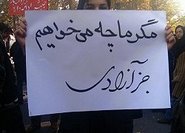


Story Highlights
Nima Arkani-Hamed, a theoretical physicist, predicts large extra dimensions
The Large Hadron Collider in Switzerland may confirm his ideas
LHC results may change ideas of spacetime for the first time since Einstein
String theory postulates that the building blocks of matter are vibrating strings
Visiting a particle accelerator is like a religious experience, at least for Nima Arkani-Hamed.
Immense detectors surround the areas where inconceivably small particles slam into one another at super-high energies, collisions that may confirm Arkani-Hamed's predictions about undiscovered properties of nature. Arkani-Hamed is only in his mid-30s, but he has already distinguished himself as one of the leading thinkers in the field of particle physics. His revolutionary ideas about the way the universe works will finally be put to the test later this year at Switzerland's Large Hadron Collider, which, when completed, will be the world's most powerful particle accelerator. The accelerator, estimated to cost between $5 billion and $10 billion, could provide answers to questions physicists have had for decades. Thousands of scientists from around the world are collaborating on the project at the European Organization for Nuclear Research, or CERN. If the results confirm any of Arkani-Hamed's predictions, they would be the first extension of our notions of spacetime since Albert Einstein. "We're essentially guaranteed that there's going to be something surprising," Arkani-Hamed said of the Large Hadron Collider, which will operate inside a 17-mile circular tunnel. See what's planned for the collider » Regarded as a "gem," Arkani-Hamed is "opening our minds and creating a new world of ideas that challenge deep-grained preconceptions about spacetime," said Chris Tully, professor of physics at Princeton University, who is working on the Compact Muon Solenoid experiment at the Large Hadron Collider. "From the point of view of the big experiments at the LHC, there is no amount of money or craftsmanship that would produce the kind of insight that comes from sharing LHC data with a true visionary like Nima Arkani-Hamed," Tully
said. Formerly a professor at Harvard, Arkani-Hamed currently sits on the faculty at the prestigious Institute for Advanced Study in Princeton, New Jersey, where Einstein served from 1933 until his death in 1955. "He was lured from Harvard to the IAS -- I'm sure that's considered quite a coup," said Daniel Marlow, a physics professor at Princeton who is also collaborating on the CMS experiment. Arkani-Hamed has had a hand in explaining how the world can operate according to Einstein's theory of general relativity, which describes the universe on a very large scale, and at the same time follow quantum mechanics, laws that describe the universe on a scale smaller than the eye can see. Some of the key mysteries that stem from these clashing theories include why gravity is so weak, relative to the other fundamental physical forces such as electromagnetism, and why the universe is so large. These issues come up because on an inconceivably small scale, the particles that make up our world seem to behave completely differently than one might imagine. For example, if you are driving a car, your GPS tells you where you are, and your speedometer tells you how fast you are moving. But on the scale of particles like electrons, it is impossible to know both position and speed at once -- the very act of trying to find out requires incredible amounts of energy. If it takes so much energy just to try to pin down a particle, then, in theory, all particles should have temporary energy changes around them called "quantum fluctuations." This energy translates into mass, since Einstein famously said that mass and energy are interchangeable through the equation E=mc2. "It makes it extremely mysterious that the electron, or indeed, everything else that we know and love and are made of, isn't incredibly more massive than it is," Arkani-Hamed said. A theory that has emerged in recent decades that claims to bring some relief to physics mysteries like these is called superstring theory, or string theory for short. While previously, scientists believed that the smallest, most indivisible building blocks of our world were particles, string theory says that the world is made of extremely small vibrating loops called strings. In order for these strings to properly constitute our universe, they must vibrate in 11 dimensions, scientists say. Everyone observes three spatial dimensions and one for time, but theoretical models suggest at least seven others that we do not see. Arkani-Hamed proposed, along with physicists Savas Dimopoulos and Gia Dvali, that some of these dimensions are larger than previously thought -- specifically, as large as a millimeter. Physicists call this the ADD model, after the first initials of the authors' last names. We haven't seen these extra dimensions yet because gravity is the only force that can wander around them, Arkani-Hamed said. String theory has come under attack because some say it can never be tested -- the strings are supposed to be smaller than any particle ever detected, after all. But Arkani-Hamed says the Large Hadron Collider could potentially lead to the direct observation of strings, or at least indirect evidence of their existence. In fact, by slamming particles into one another, the Large Hadron Collider may detect particles slipping in and out of the dimensions that Arkani-Hamed has worked on describing. Particle collisions should begin at the Large Hadron Collider in August or September, according to the US/LHC Web site. Evidence of theories such as the ADD model could be discovered by 2009, Marlow said. Data reflecting Arkani-Hamed's work on large extra dimensions "would really provide the first confirmation in this very profound way we might think about nature," Marlow said. Arkani-Hamed always had a great love of the natural world as a child. Though his parents are also physicists, he considers it his "act of teenage rebellion to become one too," as his mother wanted him to become a doctor. He remembers being impressed around age 14 that Newton's laws could enable him to calculate such things as the minimum speed that a space shuttle had to attain to escape the Earth's gravitational field. He'd wondered whether scientists had reached the figure of 11 kilometers per second by trial and error, shooting things in the air until the right speed emerged, until he could calculate it himself."When I figured out how to do that for myself, I just thought it was just the coolest thing, that little old me, scratching away on my piece of paper, could figure this out," he said. "From about 13 or 14, I knew that this is what I wanted to do." All AboutAlbert Einstein
Recent Talks:
The Future of Fundamental Physics
Approaches to the Hierarchy Problem
Perspectives on Nature's Greatest Puzzles
More on Nima Arkani-Hamed's research :source:
Nima Arkani-Hamed
Our current description of the basic interactions in nature, based on the standard model of particle physics and general relativity, is in spectacular agreement with all known experiments. However, it is almost certainly fundamentally incomplete. In addition to difficulties associated with strong quantum gravitational effects at the Planck length, sensible quantum-mechanical theory of gravity, two striking facts about nature clues suggest that we are missing a big part of the picture. The extreme weakness of gravity relative to the other forces, as well as the huge size and flatness of our observable universe, require absurdly delicate adjustments of the parameters of the theory. We expect that new physical principles will be revealed to address these puzzles � the "hierarchy problem" and the "cosmological constant problem." Fortunately, these mysteries are associated with length scales�the electroweak scale and the Hubble scale�which will be probed experimentally in the near future with particle accelerators and cosmological observations. Therefore theories which address these puzzles are likely to have experimental consequences that will be checked in the next few years. Nima Arkani-Hamed's research in theoretical physics is driven by attempting to address these mysteries. Much of his work has centered around addressing the hierarchy problem. Together with Savas Dimopoulos and Gia Dvali, he suggested that the extreme weakness of gravity can be attributed to the existence of large extra dimensions of space, perhaps as large as 100 microns in size, with the scale of quantum gravity lowered to the electroweak scale. This opens up the possibility that quantum gravitational effects can be probed at accelerators and even in table-top experiments. In a different direction, together with Andy Cohen and Howard Georgi he has constructed models where (non-gravitational) extra dimensions are generated dynamically from purely four-dimensional models. This has also led to new approaches to the hierarchy problem. He has also investigated the possibility that gravity is modified at large distances and times in an effort to address various cosmological problems. Most recently, together with Dimopoulos, he has explored the possibility that the fine-tunings for the cosmological constant and hierarchy problems find a common explanation within a huge landscape of possible low-energy worlds that may exist in string theory, leading to a novel proposal for "split" supersymmetry at the large hadron collider.
Nima Arkani-Hamed
From Wikipedia, the free encyclopedia
• Have questions? Find out how to ask questions and get answers. •
Jump to: navigation, search
Nima Arkani-Hamed
Born
1972U.S.
Fields
Physics
Institutions
Harvard University, Institute for Advanced Study
Alma mater
University of Toronto,University of California, Berkeley
Known for
Large extra dimensions, deconstruction, Little Higgs
Notable awards
Phi Beta Kappa (2005)
Nima Arkani-Hamed (born 1972) is a leading Canadian theoretical physicist with interests in high-energy physics, string theory and cosmology.
Contents[hide]
1 Academic career
2 Selected Works
3 References
4 See also
5 External links
[edit] Academic career
Nima Arkani-Hamed was born in 1972 in the U.S. to Iranian parents (also physicists) and became a Canadian citizen.
Arkani-Hamed graduated from the University of Toronto with a Joint Honours degree in Mathematics and Physics, and went to the University of California, Berkeley for his graduate studies, where he worked under the supervision of Lawrence Hall. He completed his Ph.D in 1997 and went to SLAC for post-doctoral studies. During this time he worked with Savas Dimopoulos and this is when the idea of large extra dimensions emerged. In 1999 he joined the faculty of the University of California, Berkeley physics department. He took a leave of absence from Berkeley to visit Harvard University in the spring 2001. Shortly after arriving at Harvard he worked with Howard Georgi and Andrew Cohen on idea of emergent extra dimensions, dubbed Dimensional deconstruction. These ideas eventually led to the development of little Higgs theories.
He officially joined Harvard's faculty in the fall of 2002. Arkani-Hamed has appeared on various television programmes and newspapers talking about space, time and dimensions and the current state of theoretical physics. In the summer of 2005 while at Harvard he won the 'Phi Beta Kappa' award for teaching excellence.
Nima Arkani-Hamed participated in the Stock Exchange of Visions project in 2007.
He was a Professor of Physics at Harvard University from 2002-2008, and is now on the Faculty at the Institute for Advanced Study.[1]
On May 9, 2008 he was featured on the front page of cnn.com with the headline "Physics wonder boy to test Einstein's theories."[2]
[edit] Selected Works
The paradigm of "large extra dimensions" (with Gia Dvali and Savas Dimopoulos)[3][4][5]
Deconstruction (with Howard Georgi and Andrew Cohen) [6]
Little Higgs theories [7] [8] [9] [10]
Ghost condensation [11]
Split supersymmetry (with Savas Dimopoulos) [12] [13]
[edit] References
^ Theoretical Physicist Nima Arkani-Hamed Appointed to the Faculty of the Institute for Advanced Study
^ http://www.cnn.com/2008/TECH/05/09/physics.nima/index.html
^ N. Arkani-Hamed, S. Dimopoulos, G. Dvali (1998). "The Hierarchy problem and new dimensions at a millimeter". Phys. Lett. B 436: 263-272.
^ I Antoniadis, N. Arkani-Hamed, S. Dimopoulos, G. Dvali (1998). "New dimensions at a millimeter to a Fermi and superstrings at a TeV". Phys. Lett. B 429: 257-263.
^ N. Arkani-Hamed, S. Dimopoulos, G. Dvali (1999). "Phenomenology, astrophysics and cosmology of theories with submillimeter dimensions and TeV scale quantum gravity". Phys. Rev. D 59: 086004. doi:10.1103/PhysRevD.59.086004.
^ N. Arkani-Hamed, A. G. Cohen, H. Georgi (2001). "(De)constructing dimensions". Phys. Rev. Lett. 86: 4757-4761. doi:10.1103/PhysRevLett.86.4757.
^ N. Arkani-Hamed, A. G. Cohen, H. Georgi (2001). "Electroweak symmetry breaking from dimensional deconstruction". Phys. Lett. B. 513: 232-240.
^ N. Arkani-Hamed, A. G. Cohen, T. Gregoire, J. G. Wacker (2002). "Phenomenology of electroweak symmetry breaking from theory space". JHEP 0208: 020.
^ N. Arkani-Hamed, A. G. Cohen, T. Gregoire,E. Katz, A. E. Nelson, J. G. Wacker (2002). "The Minimal moose for a little Higgs". JHEP 0208: 021.
^ N. Arkani-Hamed, A. G. Cohen, E. Katz, A. E. Nelson (2002). "The Littlest Higgs". JHEP 0207: 034.
^ N. Arkani-Hamed, H.C. Cheng, M. A. Luty, S. Mukohyama (2004). "Ghost condensation and a consistent infrared modification of gravity". JHEP 0405: 074.
^ N. Arkani-Hamed,S. Dimopoulos (2005). "Supersymmetric unification without low energy supersymmetry and signatures for fine-tuning at the LHC". JHEP 0506: 073.
^ N. Arkani-Hamed,S. Dimopoulos, G. F. Giudice, A. Romanino (2005). "Aspects of split supersymmetry". Nucl. Phys. B 0709: 3-46.
[edit] See also
Modern Iranian scientists and engineers
List of theoretical physicists
List of American Physicists
[edit] External links
Arkani-Hamed's papers in SPIRES database
Arkani-Hamed's Harvard faculty webpage
Stock Exchange Of Visions: Visions of Nima Arkani-Hamed (Video Interviews)
[1] retrieved May 9, 2008

























 اخبار مربوط به زندانیان سیاسی و نقض حقوق بشر
اخبار مربوط به زندانیان سیاسی و نقض حقوق بشر

















 Tulips in Holland
Tulips in Holland












No comments:
Post a Comment